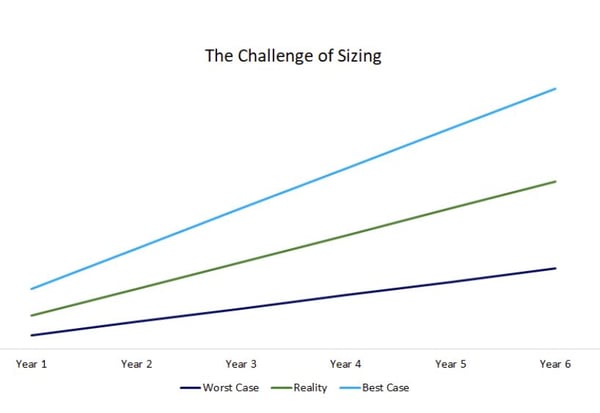Centiq disrupts traditional, monolithic SAP systems through the innovative combination of our engineering expertise. We transform your SAP platform so it is right size, agile, cost effective and as you need it.
 The challenge of sizing
The challenge of sizing
There is often more than one way to estimate future size. There will be many variables and assumptions behind each estimation method. Extrapolating into the future will have a degree of variance between each model. You will end up with a best and worst case scenario, with the reality being somewhere in between.
HW vs Cloud
Challenging project based budgeting and long hardware (HW) refresh cycles promote over-sizing based on term unknowns. Cloud Solutions can reduce waste, through a cycle of measure and grow.
This is not automatic and is an operational management overhead that requires new skills and tools.
How do I optimise workloads for cloud?
The optimal size for HANA is primarily driven by the in-memory data requirement which will depend on the workload profile, data partitioning strategy and the size of the data footprint. Each SAP application running on HANA has a different method for partitioning which impacts the ratio of data in-memory vs not-loaded. Centiq can help you develop and maintain a data management strategy, measure the impact of data strategy, forecast cloud consumption and plan and control a grow-on-demand strategy.
 On-demand resource opportunities
On-demand resource opportunities
New skills, tools and processes will need to be developed to build, update and monitor systems that have a shorter life-cycle. Switching of unused resources will be critical for minimising waste, but will need automation to reduce manual effort.
- Moving to a more dynamic build and run environment in the cloud can improve the speed of development of new initiatives.
- Infrastructure as Code and Automation techniques will improve the management of a more dynamic environment.
- With an On-Premise solution you can use virtualisation to create a degree of flexibility, but with a fixed cost base.
- With a Cloud solution you can adapt your development and testing resources to match the current demands, and costs can be reduced.
Read more about our approach to delivering successful projects here.
